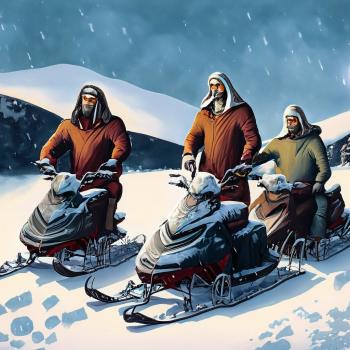
I- Spurious Scriptural Speculation
And when he had opened the seventh seal, there was silence in heaven about the space of half an hour. — Revelation 8:1
And thus, with the sword and by bloodshed the inhabitants of the earth shall mourn; and with famine, and plague, and earthquake, and the thunder of heaven, and the fierce and vivid lightning also, shall the inhabitants of the earth be made to feel the wrath, and indignation, and chastening hand of an Almighty God, until the consumption decreed hath made a full end of all nations; — Doctrine and Covenants 87:6
We’re going to try something different this week: spurious scriptural speculation. It will mostly concern the scripture in Revelation, but let’s start with the second verse: Section 87 of the Doctrine and Covenants. In this verse, written in 1832, Joseph Smith prophesied that there would be a Civil War starting in South Carolina. Which is impressive considering that this was almost 30 years before the actual Civil War, which actually did start at Fort Sumter in South Carolina. But more importantly, for our purposes, he goes from predicting the Civil War in basically a straight line to verse 6, quoted above, which ends by predicting a “full end of all nations.” But, despite his success at predicting the Civil War, it’s been over 150 years since it ended and we certainly haven’t seen the “full end of all nations.” And, frankly, the famines, plagues and vivid lightning have been underwhelming as well.
You might reply that Joseph was wrong, and that he wasn’t a prophet (though I would argue that being wrong on this one point does not mean he wasn’t a prophet.) This is certainly one possibility. But this is a Latter-day Saint blog, so we’re obviously not going to spend much time on the idea that Joseph was wrong. We’re going to proceed from the assumption that he was right. Additionally, he is not alone in predicting some sort of apocalypse. Not only do we have the rest of Christianity doing so, but there’s also a pancultural millennial impulse appearing even in places not known to be bastions of Christianity like India and China. Moreover, this was all part of the zeitgeist before we even had nuclear weapons. Surely if people felt like the apocalypse was inevitable before, the addition of nukes could only change things from “maybe” to “definitely.”
And yet, since those two terrible days in 1945, things have been fairly calm. Nukes have not been used again (outside of tests). There have been no wars between the great powers, though we’re inching towards that in Ukraine with Russia, and in Taiwan with China.
This entire period is unusual enough that people have called it the Long Peace, and others have written books about the eventual extinction of war: The Better Angels of our Nature and The Remnants of War. So if Joseph Smith predicted that the American Civil War would be the beginning of the end, why have we had seventy years of relative calm?
II- A Half Hour of Silence
Here we finally turn to the first scripture and the theme of this post, the silence in heaven and begin our speculation. Is it possible that this silence explains the Long Peace? I think it might, but to be fair I’m making some assumptions.
My first assumption is that the “silence” refers to a period of relative calm: no big disasters, no big wars, no worldwide famines or plagues, et cetera. The second assumption is that the opening of the seventh seal refers to the time immediately preceding the Second Coming. The final assumption (at least to start) is that the half hour is based on a day lasting 1,000 years.
With these initial assumptions in place it appears we might have our answer: the Long Peace is the half hour of silence mentioned in Revelation before the action really starts. In other words the Long Peace is part of the plan and Joseph wasn’t wrong, we just need to combine his apocalyptic prophecies with those of John in Revelation and it all makes sense. Except…
1000 / 24 = ~42. So one hour in a thousand year day only equals around 42 years, which means that half an hour is only around 21 years, which is way too short to account for the 70 years of peace we’ve had. Of course it does say “about” the space of a half an hour, but you would assume that anything above around 31 years (half way between our figure for a half-hour and an hour) and it would have been more accurate to say “about” the space of an hour. So at this point we’ve realized that it’s a dead end and we end this post and I see you next week, right?
No! What kind of spurious speculator would I be if I just called it a day there? The next step is obviously to take our period of 70 years and see if we can find some 21-31 year slice which might fit the bill. In other words we have to take parts of that 70 years and make them, metaphorically, noisy.
As grim as it might be, deaths are a useful proxy for “noise”. Are there any periods at the beginning or end of those 70 years which shouldn’t be included, thus reducing the time?
Looking towards the beginning of the Long Peace, while it’s commonly believed that World War II wrapped everything up in a tight little bow, Stalin and Mao were still out there. And even if you ignore the Cold War, each was killing millions of his own citizens in the years following the war.
Presumably Stalin stopped killing people when he died in 1953. (Though you never know, killing people beyond the grave is exactly the kind of thing Stalin would do.)
Mao was around much longer and is thought to have (indirectly) caused the deaths of nearly 45 million during the Great Leap Forward, which didn’t end until 1961. Most of those people died from famine, which is one of the things mentioned in section 87. In the end, regardless of the cause, the premature deaths of 45 million people (i.e. more than half of everyone who died during World War II) gives us ample justification for moving the start of the half hour of silence to at least 1962.
If the silence began in 1962, it would have ended sometime between 1983 and 1993. That still doesn’t get us where we want to be. Is there another way to push it beyond 1962?
The obvious candidate is the Cold War, but it gets that name precisely because there weren’t very many deaths — it wasn’t very noisy. There was the Korean War and Vietnam. Both of which saw the deaths of a few million people. And while I don’t want to minimize either war, they don’t quite seem to rise to the level of what we’re looking for. But if we abandon the standard of deaths (I know I’m abandoning a standard I proposed, but trust me you do this all the time during spurious speculation.) Could we make a case for the Cold War?
The best case to be made would be built around the potential for death and destruction. And while it never came to that (though it came close several times) the potential was there on a scale never before imagined. If we decide to assume that the Cold War fits our criteria for “noise” that would push the start from 1945 all the way to 1989. (I’m going with the fall of the Berlin Wall as the beginning of the end). When you combine the unraveling Soviet Union with the Tiananmen Square protests, both of which happened in 1989, it really seemed like a long nightmare had just ended.
It was earth-shattering enough to lead people like Francis Fukuyama to declare the end of history. (The essay on which the book was based was also written in 1989.) Frankly, I’m getting a pretty good feeling about 1989.
III- The End of the Storm or the Eye of the Storm?
All of this is of course rampant speculation and of limited (if not nonexistent) utility. So why engage in it? While there is a certain esoteric draw in trying to understand the scriptures in this fashion — who doesn’t enjoy some good apocalyptic nerdery — I believe there’s a larger point. For the last several decades many thought we had reached the end of the storm. It seems increasingly likely that it was instead just the eye of the storm. I believe that this interpretation is safer regardless of what you believe about either Joseph Smith or the Bible.
There are three reasons why the eye of the storm model is better:
1- It corresponds more closely to reality. People want to talk about the Long Peace, but as I pointed out 45 million people died in a four year period under Mao. This event was unique only in scale. Something similar happened in Cambodia between 1975 and 1979 when 25% of the population died. While this only represents 2 million people, it was still 25% — if translated to the US that would represent the deaths of 80 million people. Would anyone be making the Long Peace argument if that many people had died in the US regardless of whether a foreign power had anything to do with it? The Long Peace argument would appear to dismiss entirely or seriously undervalue internal political strife.
2- If we assume the storm is about to start again and we prepare accordingly, this has very little downside. As I’ve said elsewhere. If you’re wrong and the storm is over, then having been more cautious carries minimal expense. But if you’re right and it was just the eye of the storm then being more cautious may save your life.
3- Finally, if you are an active member of the Church with a testimony of Joseph Smith it accords better, not only with what he said but with what more recent prophets have been saying.
Of course just knowing that you’re in the eye of the storm doesn’t allow you to stop the hurricane. You can only survive it.
IV- So When Does the Half Hour of Silence End? When Will the Storm Start Anew?
You may have noticed that, after concluding that the half hour of silence ended in 1989, I never took the obvious next step and calculated when the silence would end. You may have already done the calculation, but if not, it would end sometime between 2010 and 2020.
Wouldn’t you know it, but right on schedule 2020 brought a worldwide plague — one of the things mentioned in D&C 87. Also a case could be made that things started getting loud with the election of Trump in 2016. Regardless of your political affiliation you would have to agree that it was pretty consequential.
Things have not settled down since then. The late twenty-teens were pretty chaotic, with Brexit in 2017 and 2019 being called the year of protest. While neither of those things amount to much in the historical scheme of things, they could also be the first drops of rain before the storm begins in earnest.
If we look after 2020 the big event is Russia’s invasion of Ukraine 2022, though of course hostilities between the two countries have been ongoing since 2014. Beyond that there’s the continuing and growing hostility between the US and China, the increasingly acrimonious culture war, and the apocalyptic predictions of doom coming out of the AI community.
It’s hard to know how any of this is going to turn out, but there’s significant and mounting cause for concern.
As we conclude I will remind you that this is all just spurious speculation. With enough contortions and assumptions (and this post had plenty) you can arrive at any conclusion. And we have been told: “But of that day and hour knoweth no man, no, not the angels of heaven, but my Father only.”
Still, my speculation might be accurate, stranger things have happened, and in this matter one prefers to err on the side of credulity. The end of the world is not something you want to be caught off guard by. Nevertheless I admit the future is unknown. Perhaps the troubles of the 2020s are all but over. Or perhaps this is the beginning of The End. Most likely it’s somewhere in between those two extremes. But we live in a time of portents and omens, and it might not be wise to ignore this one.
If you prefer to listen to this post click here.












